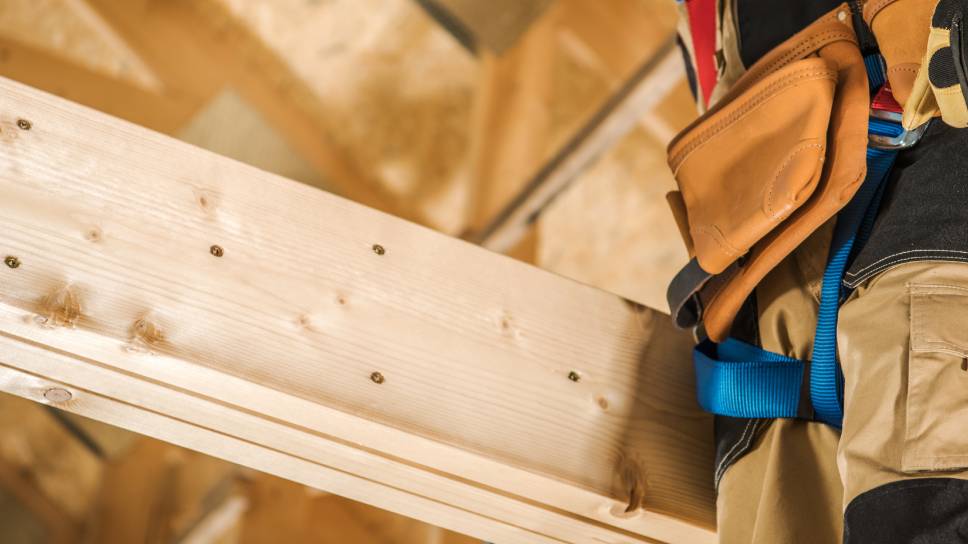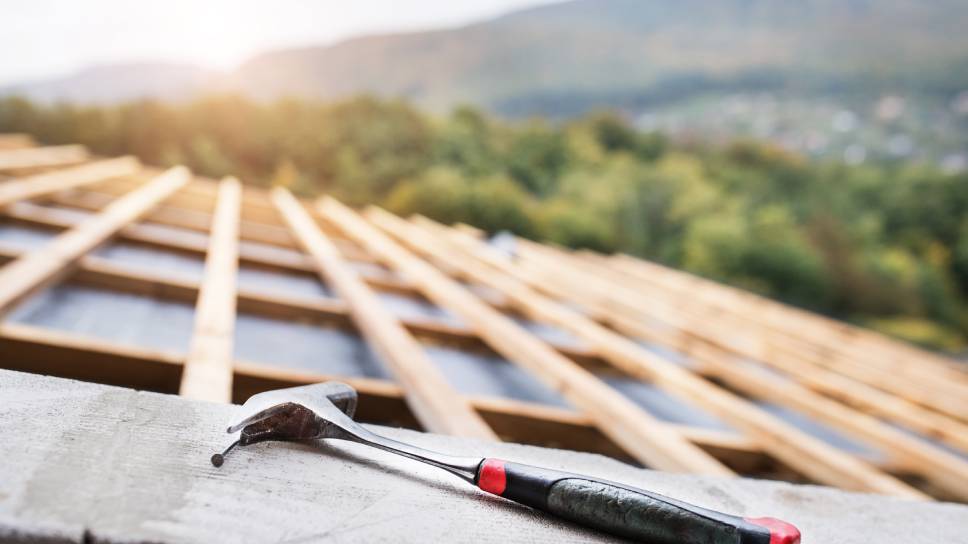What can you learn from this article?
- What is a roof truss?
- Types of roof truss
- Roof truss material
- Shape of the roof truss and roof design
- Attic and its thermal insulation
The hipped roof end is usually laid at the end of the pre-lock-up stage of the house, which then becomes a closed, monolithic structure. However, before the roof itself is installed, roofers build a wooden structure, which becomes the basis for roof covering with a suitable material.
The choice of roof trusses affects both the costs of the entire project and the type of technology used for its construction, the type of materials or even the size and height of the attic. Right selection of the roof truss structure depends among others on the purpose of the building, size and span of the roof and even climatic conditions such as wind strength, amount of precipitation and duration of snowfall.
Every house may have a slightly different roof, but every house has a roof truss.
What is a roof truss?
The roof truss is a wooden frame of the roof which carries the loads from the roof covering. It is the angle of inclination of the roof truss that determines the degree of water drainage (e.g. on high roofs snow will not accumulate). The structure of the roof truss should be thoroughly considered, as its type will determine the ability to accommodate any additional attic space in the future.
Roof truss components
- tie beam
- wall plate
- rafter
- purlin
- ties
- truss
- post
- angle brace
- diagonal brace
- hanger
- cross-brace
- pull-up
- wind beam
- overlap
The purpose of the tie beam is to prevent the walls of the building from collapsing or falling down; the wall plate transfers the load from the roof truss to the walls, and the rafter is the sloped beam to which the battens or purlins (the elements to which the roofing is attached) are fixed.
A purlin is a structural element of the roof laid in a line parallel to the roof ridge. The ties, in turn, consist of two parallel parts made of timber or join two adjacent posts frames as part of tie-purlin roof trusses. The purpose of the roof truss, as the primary load-bearing element of the roof structure, is to transfer loads to the main supports.
A post is a wooden column located in a tie-purlin roof truss structure, while a brace is a wooden beam in wall frame structures and roof trusses. The diagonal brace, in turn, is a diagonal timber beam, the hanger is a tensile member of a hanger truss structure, and the cross-brace is a diagonal member of a truss structure.

The roof truss structure also consists of a pull-up (a beam that is usually a support for the ceiling, for other supporting beams, walls, and columns) and a wind beam, which is a wooden board fastened to the rafters from below.
Types of roof truss
Single-family houses usually have a rafter roof truss, rafter-collar beam roof truss or purlin-ties roof truss. What the roof truss will look like depends on the type of roof to be installed and whether the attic will be used for utility purposes.
Rafter roof truss
The rafter roof is the simplest possible structure. It is applied when the span of external walls does not exceed 7 m and the roof slope inclination is 40-60°. In the case of rafter roof truss, the permissible length of a single rafter is 6 m.
Its basic load-bearing element is a pair of rafters which are joined together at the roof ridge. The rafters are spaced at intervals of 70-100 cm, and their lower ends are fastened to a horizontal tie beam, which is also the load-bearing structure of the ceiling. The lower ends of the rafters can also be fastened to wall plates located on the ceiling or on top of elbow walls.
When selecting such a solution it must be remembered that both the rafter fixing to the wall plates and the wall plate fixing to the building structure must be carried out in a proper manner. These fastenings will determine the later stability and general safety of the entire roof structure.
The advantage of this type of structure is its easy and quick installation, as well as relatively low cost of the entire project. The disadvantages of such a solution are limited use, frequent occurrence of surface curvature (long sections without support) of rafters, as well as the action of forces pushing (outside) the walls.

Rafter-beam roof truss
A pair of rafters (spaced 80-120 cm apart) and the horizontal beam of the timber ceiling form the basis for this type of roof structure, resulting in a three-element truss that is supported on the outer walls of the building.
The beams forming the horizontal timber floor may be supported directly on the wall or on the wall plate. The rafter-beam roof truss is used in buildings where the span of the external walls does not exceed 6-7 m. The permissible length of a single rafter is 7 m.
Collar-beam roof truss
The collar-beam roof truss is a structure distinguished by simplicity of implementation, economy and fewer constructional limitations in comparison to e.g. rafter solution. All this contributes to the wide demand for rafter framing in single-family housing construction nowadays.
This type of solution is used for wall spans of 5 to 12 m and roof slope angles of 25-67o (recommended minimum is 35o).
The collar-beam roof truss is in fact a slightly improved variant of the rafter truss, to which a horizontal element, the roof collar beam, has been added. It is usually located in the middle of the rafter length (or slightly higher), and its function is to connect the rafters firmly and stiffen them properly. As a general rule, the lower part of the rafter (from the sill to the mayfly) should not exceed 4.5 m in length, while the upper part (between the collar beam and the roof ridge) should not exceed 2.7 m.
Depending on the span of the roof, different types of collar-beam roof trusses are used. As part of the standard collar beam roof truss, the length of the collar beam can be up to 3.5 m. In the case of a house with a utility attic, its lower edge must be 2-2.4 m above floor level. In the case of roofs with a slight angle of inclination, it is necessary to provide reinforced elbow walls. This helps ensure proper height of the attic. Recommended rafter spacing for this solution is 70-100 cm.
For roof spans of 9-12 m, a purlin-collar beam roof truss is also used. It is built of pairs of rafters spanned by collar beams, which are supported by one or two additional post beam walls. When the roof span is 7.5-10 m then one purlin is applied only, when it is 9-12 m then two purlins are applied. The diagonal elements (diagonal braces) stiffen the entire structure of the post wall and provide additional support for the purlins.
Purlin-ties roof truss
The purlin-ties solution is applied when the wall span exceeds 11 m. Both wall plates and purlins are used as rafter supports. They provide adequate reinforcement for the rafters about halfway along the span. The purlins are supported by posts, placed on the ceiling purlins or directly on the ceiling.
The purlin-ties roof truss is stiffened by horizontal ties (every third or fourth rafter pair). These are double beams that tie the ends of the posts to the rafters that rest on them. This roof structure ensures an even distribution of loads on the entire building and provides the most even roof slope. The disadvantage of this solution is that it partly limits the use of the attic space. However, the purlin-ties roof truss is currently the most universal solution, perfect for both flat and steep roofs (6-70 degrees).
Roof truss material
Roof trusses are mainly made of pine or spruce wood; sometimes fir or larch wood is also used. The wood used for the roof construction is delivered to roofers in the form of boards, battens, logs, square timbers or beams.
Timber is not a homogeneous material and often has defects which significantly affect its strength, therefore the grade of wood should be in accordance with the one determined as part of the project (at least C 24). The timber grade indicates its bending strength and, of course, the higher the grade, the better it is.
Shape of the roof truss and roof design
When choosing a design for your house, it is important to consider the shape of the roof, its span and its type. The design will - to some extent - determine the final design of the building's roof. In principle, the type of roof structure will be determined by what roof shape has been planned and designed by the architect. The external dimensions of the building will also determine it. Designing the roof truss is the responsibility of the architect, while its professional implementation should be left to the construction team. Please remember that correct erection of the roof trusses has a huge impact on the safety of the entire building.
Attic and its thermal insulation
Once the roof truss has been erected and the roof sheathing placed on it, the structure of the entire house is completed, including of course the window and door frames. Then you can think about the proper insulation of the attic.
When planning thermal insulation works, it is worth paying attention to the durability of the used material and its energy efficiency. PUR foam is vapour-permeable and perfectly suitable for insulating attics, ceilings, and walls in residential buildings as it prevents condensation. Filling all spaces with the spraying method, the PUR foam becomes a uniform and continuous insulation within several seconds, and no thermal bridges are formed in the rooms insulated with this material.
Application of the foam is a relatively simple and quick, provided that it is carried out by professionals. As soon as it is sprayed on, the material expands one hundred times and becomes usable very quickly. Open-cell foamis more commonly used in attics, as it is cheaper. The minimum layer applied on individual attic elements should be about 25 centimetres (according to the requirements of WT 2021 - the U-value for the roof should not exceed 0.15 W/m2K).
Insulating an attic of 150 m2 with a 25 cm thick foam layer allows you to save a significant amount of money in your household budget. Not only does foam insulation meet the highest standards, but it also reduces your bills by several dozen percent.

 This website uses cookies. By using this website, you consent to the use of cookies in accordance with your browser settings.
This website uses cookies. By using this website, you consent to the use of cookies in accordance with your browser settings.